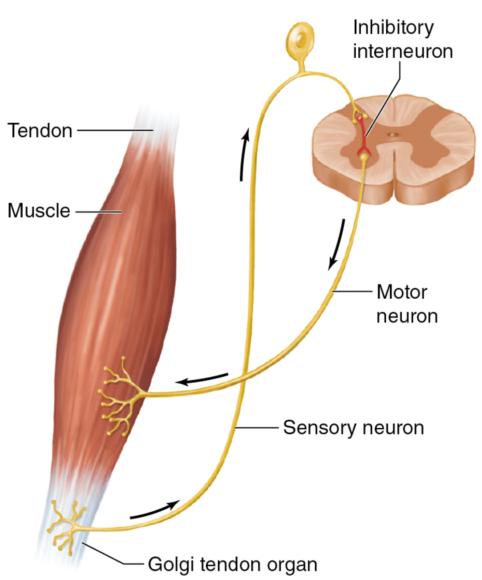Properties of muscle and tendon
This is an excerpt from Plyometric Anatomy by Derek Hansen,Steve Kennelly.
The muscle spindle fibers are the primary sensory mechanism for triggering a powerful concentric contraction in a plyometric movement. Another sensory organ in the muscle-tendon unit is the Golgi tendon organ (figure 1.3). This particular stretch receptor is located in the tendons and, when stretched forcefully, transmits signals to the spinal cord to create an inhibitory response to a contracted muscle. In this way, the action of the Golgi tendon organ has been portrayed as a protective mechanism to prevent the muscle from excessive tension and potential injury. This reflex mechanism is demonstrated when a person jumps from an extreme height and collapses to the ground, sometimes rolling out of the landing to dissipate forces and avoid injury. It is important to recognize that both of these sensory organs may come into play when planning and implementing a plyometric exercise program, particularly when identifying optimal jump heights. A jump from a box at a moderate height may produce enough force to create an eccentric stretch that activates the muscle spindles for a powerful concentric response. However, a jump from an excessively high box may stretch a tendon rapidly and invoke an inhibitory response from Golgi tendon organs, ultimately shutting down a concentric contraction.

Golgi tendon organ.
While the sensory mechanisms required for an explosive muscular response are critical elements in plyometrics, the contractile components of muscle play a significant role in the creation of movement. The basic force-generating elements of muscle are the actin and myosin myofilaments formed from individual actin and myosin molecules. These myofilaments collectively make up the myofibrils in individual muscle fibers. These muscle fibers form larger bundles of the muscle fasciculi that combine to make up the skeletal muscles that create human movement. In a contracting muscle, movement is initiated when the actin and myosin filaments form cross-bridges and slide past one another. The sliding action occurs through a cyclic attachment and detachment of myosin on the actin filaments (Spudich 2001). When a muscle is stretched while activated, the isometric force achieved after the stretch is higher than that produced during normal isometric contractions at the same length (Abbott and Aubert 1952; Rassier et al. 2003). It has been suggested that force enhancement and increased stiffness are associated with cross-bridge mechanics: The proportion of cross-bridges after a stretch is higher than that associated with an isometric contraction (Herzog and Leonard 2000).
Other elements that contribute to the explosive-performance properties of muscle are known as the series elastic components. In series elastic components, muscle fibers, including the cross-bridging elements of actin and myosin myofilaments, are connected in line with elastic structures such as tendons. The elongation of these series elastic components during muscle contractions produces potential energy similar to that of a loaded spring or a stretched rubber band (Hill 1950). As mentioned previously, if the amortization phase of a plyometric movement is too long, the potential energy stored in the elasticity of muscles will dissipate and the benefits of eccentric loading are lost, primarily in the form of heat energy (Cavagna 1977). The rate of loading has been found to be of more consequence than the length or magnitude of stretch in a muscle-tendon complex (Bosco and Komi 1979). An important consideration in any plyometric exercise is to ensure that the loading phase and prestretch of the series elastic components are quick, resulting in a more explosive and elastic movement.
Learn more about Plyometric Anatomy.
More Excerpts From Plyometric AnatomySHOP

Get the latest insights with regular newsletters, plus periodic product information and special insider offers.
JOIN NOW


